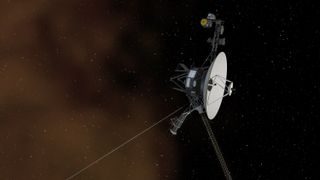NASA's iconic Voyager 1 marks 45 years in space
Voyager 1 has accomplished a lot during its long life.

NASA's venerable Voyager 1 spacecraft has reached a key milestone.
The Voyager 1 probe launched 45 years ago, on Sept. 5, 1977, just weeks after its twin Voyager 2 but soon overtaking it. The two spacecraft were designed to fly past Jupiter and Saturn, taking advantage of a favorable solar system alignment. At the time, no one expected the spacecraft to still be working more than four decades later. But now, the Voyagers are stretching toward a round 50 years in space. Voyager 1 is currently more than 14.6 billion miles (23.5 billion kilometers) from Earth — that's more than 157 times the distance from our planet to the sun — and is traveling outward at a speed of 38,000 mph (60,000 kph).
"Today, as both Voyagers explore interstellar space, they are providing humanity with observations of uncharted territory," Linda Spilker, Voyager's deputy project scientist at NASA's Jet Propulsion Laboratory (JPL) in California, said in a statement.
Gallery: Celebrate 45 years of Voyager with these amazing images of our solar system
Voyager 1 in particular has something to celebrate with this anniversary, since NASA recently managed to fix a glitch that had caused the spacecraft to rely on a defunct computer, which led to the probe sending gibberish data home to Earth.
Although mission personnel have gotten the spacecraft back on track, they're still looking into what triggered the switch, according to a NASA statement.
After the 1977 launch, the mission's milestones came fast. Voyager 1 got its first look at Jupiter in April 1978 and made its closest approach to the massive planet in March 1979. The spacecraft also caught glimpses of Jupiter's moons, including Io, the strange volcanic surface of which Voyager 1 unveiled.
Get the Space.com Newsletter
Breaking space news, the latest updates on rocket launches, skywatching events and more!
Then, the probe headed out to Saturn and its largest moon, Titan, making its flyby in November 1979, just over two years after launch. Voyager 1's detour to catch a closer look at Titan meant it didn't make any more flybys; its twin Voyager 2 instead continued sailing out to Uranus and Neptune.
Voyager 1 became the most distant human-made object in 1998, according to NASA, and marked 100 times the distance from Earth to the sun in 2006.

In 2012, Voyager 1 entered interstellar space, the region beyond the heliosphere, which is the bubble formed by charged particles constantly streaming off the sun and out into space. Beyond the heliosphere, the spacecraft registers far more cosmic rays — fragments of atoms that zip through space — than solar particles.
"This is the first time we've been able to directly study how a star, our sun, interacts with the particles and magnetic fields outside our heliosphere," Spilker added, "helping scientists understand the local neighborhood between the stars, upending some of the theories about this region and providing key information for future missions."
Although four instruments on the Voyager 1 probe are still gathering data to send to Earth, mission personnel expect they will need to turn off additional instruments as time passes and the probe's nuclear power source weakens.
Eventually, the twin probes will fall silent — although they will continue to zip through space for billions of years.
"The Voyagers have continued to make amazing discoveries, inspiring a new generation of scientists and engineers," Suzanne Dodd, project manager for Voyager at JPL, said in the same statement. "We don't know how long the mission will continue, but we can be sure that the spacecraft will provide even more scientific surprises as they travel farther away from the Earth."
Email Meghan Bartels at mbartels@space.com or follow her on Twitter @meghanbartels. Follow us on Twitter @Spacedotcom and on Facebook.
Join our Space Forums to keep talking space on the latest missions, night sky and more! And if you have a news tip, correction or comment, let us know at: community@space.com.

Meghan is a senior writer at Space.com and has more than five years' experience as a science journalist based in New York City. She joined Space.com in July 2018, with previous writing published in outlets including Newsweek and Audubon. Meghan earned an MA in science journalism from New York University and a BA in classics from Georgetown University, and in her free time she enjoys reading and visiting museums. Follow her on Twitter at @meghanbartels.
